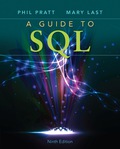
A Guide to SQL
9th Edition
ISBN: 9781337668880
Author: Pratt
Publisher: Cengage
expand_more
expand_more
format_list_bulleted
Concept explainers
Question
Chapter 1, Problem 12CAT
Program Plan Intro
SELECT statement:
It is used to retrieve information from the table or
Syntax:
SELECT * FROM table_Name;
DISTINCT Keyword:
“DISTINCT” keyword is used to avoid redundant data (removing duplicate values) from a column. The syntax for “DISTINCT” keyword is as follows:
SELECT DISTINCT column_Name FROM table_Name;
Expert Solution & Answer
Trending nowThis is a popular solution!

Students have asked these similar questions
Dijkstra's Algorithm (part 1). Consider the network shown below, and Dijkstra’s link-state algorithm. Here, we are interested in computing the least cost path from node E (note: the start node here is E) to all other nodes using Dijkstra's algorithm. Using the algorithm statement used in the textbook and its visual representation, complete the "Step 0" row in the table below showing the link state algorithm’s execution by matching the table entries (i), (ii), (iii), and (iv) with their values. Write down your final [correct] answer, as you‘ll need it for the next question.
4. |z + 5 - 5i| = 7
14.
dz,
C: |z❘
C: |z❘ = 0.6
ze² - 2iz
H
Chapter 1 Solutions
A Guide to SQL
Ch. 1 - Prob. 1TDCh. 1 - Prob. 2TDCh. 1 - Prob. 3TDCh. 1 - Prob. 4TDCh. 1 - Prob. 5TDCh. 1 - Prob. 6TDCh. 1 - Prob. 7TDCh. 1 - Prob. 8TDCh. 1 - Prob. 9TDCh. 1 - Prob. 10TD
Ch. 1 - Prob. 11TDCh. 1 - Prob. 1CATCh. 1 - Prob. 2CATCh. 1 - Prob. 3CATCh. 1 - Prob. 4CATCh. 1 - Prob. 5CATCh. 1 - Prob. 6CATCh. 1 - Prob. 7CATCh. 1 - Prob. 8CATCh. 1 - Prob. 9CATCh. 1 - Prob. 10CATCh. 1 - Prob. 11CATCh. 1 - Prob. 12CATCh. 1 - Prob. 13CATCh. 1 - Prob. 14CATCh. 1 - Prob. 1SCGCh. 1 - Prob. 2SCGCh. 1 - Prob. 3SCGCh. 1 - Prob. 4SCGCh. 1 - Prob. 5SCGCh. 1 - Prob. 6SCGCh. 1 - Prob. 7SCGCh. 1 - Prob. 8SCGCh. 1 - Prob. 9SCGCh. 1 - Prob. 10SCGCh. 1 - Prob. 11SCGCh. 1 - Prob. 12SCGCh. 1 - Prob. 13SCG
Knowledge Booster
Learn more about
Need a deep-dive on the concept behind this application? Look no further. Learn more about this topic, computer-science and related others by exploring similar questions and additional content below.Similar questions
arrow_back_ios
SEE MORE QUESTIONS
arrow_forward_ios
Recommended textbooks for you
 A Guide to SQLComputer ScienceISBN:9781111527273Author:Philip J. PrattPublisher:Course Technology Ptr
A Guide to SQLComputer ScienceISBN:9781111527273Author:Philip J. PrattPublisher:Course Technology Ptr

A Guide to SQL
Computer Science
ISBN:9781111527273
Author:Philip J. Pratt
Publisher:Course Technology Ptr
